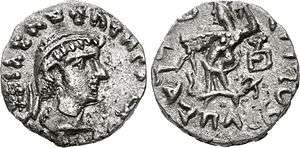Northern Satraps
| Northern Satraps | |||||||||
|---|---|---|---|---|---|---|---|---|---|
| 60 BCE–2nd century CE | |||||||||
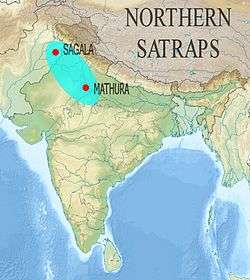 The Northern Satraps ruled the area from Eastern Punjab to Mathura. | |||||||||
| Capital | Sagala/ Mathura | ||||||||
| Religion | Buddhism | ||||||||
| Government | Monarchy | ||||||||
| Historical era | Antiquity | ||||||||
• Established | 60 BCE | ||||||||
• Disestablished | 2nd century CE | ||||||||
| |||||||||
| Today part of |
| ||||||||
The Northern Satraps are a dynasty of Indo-Scythian rulers who held sway over the area of Mathura and Eastern Punjab from the 1st century BCE to the 2nd century CE. They are called "Northern Satraps", in opposition to the "Western Satraps" ruling in Gujarat and Malwa at roughly the same time. They are thought to have replaced the last of the Indo-Greek kings in the Eastern Punjab, as well as the Mitra dynasty and the Datta dynasty of local Indian rulers in Mathura.
The Northern Satraps were probably displaced by, or became vassals of, the Kushans from the time of Vima Kadphises, who is known to have ruled in Mathura in 90–100 CE, and they are known to have acted as Satraps and Great Satraps in the Mathura region for his successor Kanishka (127–150 CE).
Northern Satraps
In central India, the Indo-Scythians are thought to have conquered the area of Mathura over Indian kings, presumably the Datta dynasty, around 60 BCE. Due to being under the scrutiny of the Kushan Empire, as a satrapy and not wholly independent, they were called the Northern Satraps. Some of their first satraps were Hagamasha and Hagana, they were in turn followed by Rajuvula who gained the title Mahakshatrapa or great satrap. However, according to some authors, Rajuvula may have been first..
Rajuvula

Obv: Bust of King Rajuvula, with Greek legend.
Rev: Pallas standing right (crude).[1] Kharoshthi legend.
Rajuvula is considered as one of the main Northern Satraps. He was a Great Satrap (Mahakshatrapa) who ruled in the area of Mathura in northern India in the years around 10 CE, under the authority of the Indo-Scythian king Azilises.[1] In Mathura, he sometimes used the term "Basileus" (king) next to his title of Satrap, which implies a higher level of autonomy from the Indo-Scythian center in northwestern India.[1]
In Mathura, Rajuvula established the famous Mathura lion capital, now in the British Museum, which confirms the presence of Northern Satraps in Mathura, and sheds some light on the relationships between the various satraps of Northern India.[2] His coins are found near Sankassa along the Ganges and in Eastern Punjab. Their style is derived from the Indo-Greek types of Strato II.[2][1] Rajuvula conquered the last remaining Indo-Greek kingdom, under Strato II, around 10 CE, and took his capital city, Sagala. Numerous coins of Rajuvula have been found in company with the coins of the Strato group in the Eastern Punjab (to the east of the Jhelum) and also in the Mathura area:[3] for example, 96 coins of Strato II were found in Mathura in conjunction with coins of Rajuvula, who also imitated the designs of Strato II in the majority of his issues.[4]
The coinage of the period, such as that of Rajuvula, tends to become very crude and barbarized in style. It is also very much debased, the silver content becoming lower and lower, in exchange for a higher proportion of bronze, an alloying technique (billon) suggesting less than wealthy finances.
Mathura lion capital
The Mathura lion capital, an Indo-Scythian sandstone capital in crude style, from Mathura in Central India, and dated to the 1st century CE, describes in kharoshthi the gift of a stupa with a relic of the Buddha, by Queen Nadasi Kasa, the wife of the Indo-Scythian ruler of Mathura, Rajuvula.
The capital describes, among other donations, the gift of a stupa with a relic of the Buddha, by Queen Ayasia, the "chief queen of the Indo-Scythian ruler of Mathura, satrap Rajuvula". She is mentioned as the "daughter of Kharahostes" (See: Mathura Lion Capital inscriptions). The lion capital also mentions the genealogy of several Indo-Scythian satraps of Mathura. It mentions Sodasa, son of Rajuvula, who succeeded him and also made Mathura his capital.
Sodasa and Bhadayasa
Sodasa, son of Rajuvula, seems to have replaced his father in Mathura, while Bhadayasa ruled as Basileus in Eastern Punjab.[6][7][8] Bhadayasa has some of the nicest coins of the Northern Satraps, in direct inspiration from the coins of the last Indo-Greek kings.
The coinage of Sodasa is cruder and of local content: it represents a Lakshmi standing between two symbols on the obverse with an inscription around Mahakhatapasa putasa Khatapasa Sodasasa "Satrap Sodassa, son of the Great Satrap". On the reverse is a standing Abhiseka Lakshmi (Lakshmi standing facing a Lotus flower with twin stalks and leaves) anointed by two elephants sprinkling water, as on the coins of Azilises.[6][9]
Sodasa is also known from various inscriptions where he is mentioned as ruler in Mathura, such as the Kankali Tila tablet of Sodasa.
Contribution to Sanskrit epigraphy
In what has been described as "the great linguistical paradox of India", Sanskrit inscriptions first appeared much later than Prakrit inscriptions, although Prakrit is considered as a descendant of the Sanskrit language.[11] This is because Prakrit, in its multiple variants, had been favoured since the time of the influential Edicts of Ashoka (circa 250 BCE).[11]
Besides a few examples from the 1st century BCE, most of the early Sanskrit inscriptions date to the time of the Indo-Scythian rulers, either the Northern Satraps around Mathura for the earliest ones, or, slightly later, the closely related Western Satraps in western and central India.[12][13] It is thought that they became promoters of Sanskrit as a way to show their attachment to Indian culture.[13] According to Salomon "their motivation in promoting Sanskrit was presumably a desire to establish themselves as legitimate Indian or at least Indianized rulers and to curry the favor of the educated Brahmanical elite".[14]
The Sanskrit inscriptions in Mathura (Uttar Pradesh) are dated to the 1st and 2nd-century CE.[12] The earliest of these, states Salomon, are attributed to Sodasa from the early years of 1st-century CE. Of the Mathura inscriptions, the most significant is the Mora Well Inscription.[12] In a manner similar to the Hathibada inscription, the Mora well inscription is a dedication inscription and is linked to the Vaishnavism tradition of Hinduism. It mentions a stone shrine (temple), pratima (murti, images) and calls the five Vrishnis as bhagavatam.[12][15] There are many other Mathura Sanskrit inscriptions overlapping the era of Indo-Scythian Northern Satraps and early Kushanas, although they are still dwarfed by the number of contemporary inscriptions in Prakrit.[12] Other significant 1st-century inscriptions in reasonably good classical Sanskrit include the Vasu Doorjamb Inscription and the Mountain Temple inscription.[16] The early ones are related to the Brahmanical and possibly Jain traditions, as in the case of an inscription from Kankali Tila,[17][18] and none are Buddhist.
The development of Sanskrit epigraphy in western India under the Western Satrap, is also thought to have been the result of the influence of the Northern Satraps on their western relatives.[19]
Successors
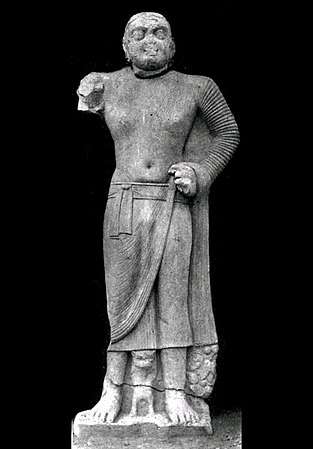
Several successors are known to have ruled as vassals to the Kushans, such as the Mahakshatrapa ("Great Satrap") Kharapallana and the Kshatrapa ("Satrap") Vanaspara, who are known from an inscription discovered in Sarnath, and dated to the 3rd year of Kanishka (c. 130 CE), in which Kanishka mentions they are the governors of the eastern parts of his Empire, while a "General Lala" and Satraps Vespasi and Liaka are put in charge of the north.[20][21][22] The inscription was discovered on an early statue of a Boddhisattva, the Sarnath Bala Boddhisattva, now in the Sarnath Museum .[23]
The "Northern Satraps" Rulers (Mathura area)
- Hagamasha (satrap, 1st century BCE)
- Hagana (satrap, 1st century BCE)
- Rajuvula, c. CE 10 (Great Satrap)
- Sodasa, son of Rajuvula in Mathura, Bhadayasa in Eastern Punjab.[7][8]
- "Great Satrap" Kharapallana (c. CE 130)
- "Satrap" Vanaspara (c. CE 130)
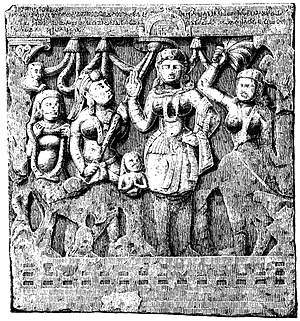
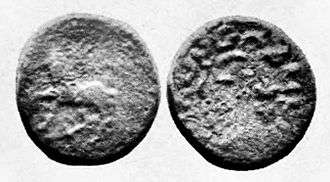 Coin of satrap Hagamasha. Obv. Horse to the left. Rev. Standing figure with symbols, legend Khatapasa Hagāmashasa. 1st century BCE.
Coin of satrap Hagamasha. Obv. Horse to the left. Rev. Standing figure with symbols, legend Khatapasa Hagāmashasa. 1st century BCE.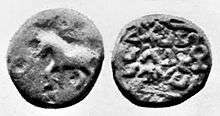 Joint coin of Hagana and Hagamasha. Obv.: Horse to left. Rev. Thunderbolt, legend Khatapāna Hagānasa Hagāmashasa. 1st century BCE.
Joint coin of Hagana and Hagamasha. Obv.: Horse to left. Rev. Thunderbolt, legend Khatapāna Hagānasa Hagāmashasa. 1st century BCE.
References
- 1 2 3 4 5 History of Early Stone Sculpture at Mathura: Ca. 150 BCE - 100 CE, Sonya Rhie Quintanilla, BRILL, 2007, p.170
- 1 2 The Dynastic Arts of the Kushans, by John M. Rosenfield, University of California Press, 1967 p.135
- ↑ Mathurā and Its Society: The ʼSakæ-Pahlava Phase, Bratindra Nath Mukherjee, Firma K.L.M., 1981, p.9
- ↑ Bibliography of Greek coin hoards, p. 194-195
- ↑ Senior ISCH vol. II, page 129.
- 1 2 The Dynastic Arts of the Kushans, John M. Rosenfield, University of California Press, 1 janv. 1967, p.136
- 1 2 Marshall, J. (2013). A Guide to Taxila. Cambridge University Press. p. 44. ISBN 9781107615441. Retrieved 2016-12-05.
- 1 2 "CNG: Printed Auction CNG 93. INDO-SKYTHIANS, Northern Satraps. Bhadrayasha. After 35 BC. AR Drachm (17mm, 2.10 g, 1h). (CNG Coins notice)". cngcoins.com. Retrieved 2016-12-05.
- ↑ Foreign Influence on Ancient India, Krishna Chandra Sagar, Northern Book Centre, 1992, p.126
- ↑ Buddhist art of Mathurā , Ramesh Chandra Sharma, Agam, 1984 Page 26
- 1 2 Salomon 1998, pp. 86-87.
- 1 2 3 4 5 Salomon 1998, pp. 87-88.
- 1 2 Salomon 1998, pp. 93-94.
- ↑ Salomon 1998, p. 93.
- ↑ Sonya Rhie Quintanilla (2007). History of Early Stone Sculpture at Mathura: Ca. 150 BCE - 100 CE. BRILL Academic. p. 260-263. ISBN 90-04-15537-6.
- ↑ Sonya Rhie Quintanilla (2007). History of Early Stone Sculpture at Mathura: Ca. 150 BCE - 100 CE. BRILL Academic. p. 260. ISBN 90-04-15537-6.
- ↑ Inscription No21 in Janert, l (1961). Mathura Inscriptions.
- ↑ Salomon 1998, p. 88.
- ↑ Salomon 1998, pp. 86-93.
- ↑ Ancient Indian History and Civilization, Sailendra Nath Sen New Age International, 1999, p.198
- ↑ Foreign Influence on Ancient India, Krishna Chandra Sagar, Northern Book Centre, 1992 p.167
- ↑ Source: "A Catalogue of the Indian Coins in the British Museum. Andhras etc..." Rapson, p ciii
- ↑ Papers on the Date of Kaniṣka, Arthur Llewellyn Basham, Brill Archive, 1969, p.271
- ↑ The Jain stûpa and other antiquities of Mathurâ by Smith, Vincent Arthur Plate XIV
Indo-Scythian kings, territories and chronology | |||||||||||||||||||||||||||||||||||||||||||||||||||||||||||||||||||||||||||||||||||||||||||||||||||||||||||||||||||||||||||||||||||||||||||||||||||||||||||||||||||||||||||||||||||||||||||||||||||||||||||||||||||||||||||||||||||||
|---|---|---|---|---|---|---|---|---|---|---|---|---|---|---|---|---|---|---|---|---|---|---|---|---|---|---|---|---|---|---|---|---|---|---|---|---|---|---|---|---|---|---|---|---|---|---|---|---|---|---|---|---|---|---|---|---|---|---|---|---|---|---|---|---|---|---|---|---|---|---|---|---|---|---|---|---|---|---|---|---|---|---|---|---|---|---|---|---|---|---|---|---|---|---|---|---|---|---|---|---|---|---|---|---|---|---|---|---|---|---|---|---|---|---|---|---|---|---|---|---|---|---|---|---|---|---|---|---|---|---|---|---|---|---|---|---|---|---|---|---|---|---|---|---|---|---|---|---|---|---|---|---|---|---|---|---|---|---|---|---|---|---|---|---|---|---|---|---|---|---|---|---|---|---|---|---|---|---|---|---|---|---|---|---|---|---|---|---|---|---|---|---|---|---|---|---|---|---|---|---|---|---|---|---|---|---|---|---|---|---|---|---|---|---|---|---|---|---|---|---|---|---|---|---|---|---|---|---|---|
| |||||||||||||||||||||||||||||||||||||||||||||||||||||||||||||||||||||||||||||||||||||||||||||||||||||||||||||||||||||||||||||||||||||||||||||||||||||||||||||||||||||||||||||||||||||||||||||||||||||||||||||||||||||||||||||||||||||
| |||||||||||||||||||||||||||||||||||||||||||||||||||||||||||||||||||||||||||||||||||||||||||||||||||||||||||||||||||||||||||||||||||||||||||||||||||||||||||||||||||||||||||||||||||||||||||||||||||||||||||||||||||||||||||||||||||||
